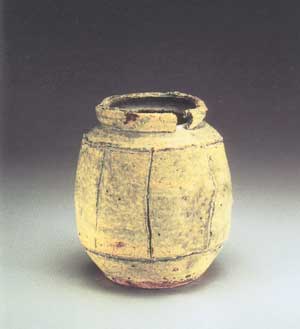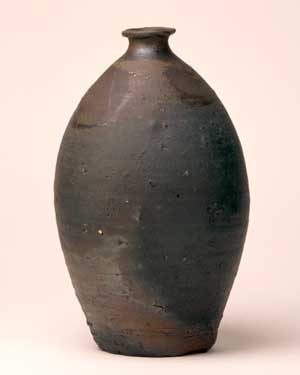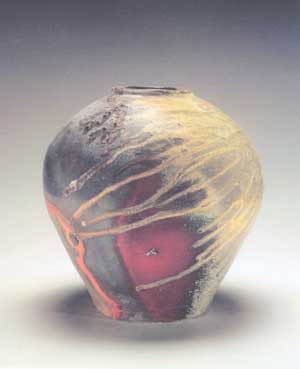Beyond East and West
by Jane Addams Allen
Rob Barnard returned from Japan in 1978, the same year that English potter Bernard Leach (1887-1979) published his last book, Beyond East and West. There is a nice continuity in this coincidence of dates. Like Leach in 1920, Barnard returned home determined to effect a synthesis of East and West in his pottery. Like Leach, Barnard is determined to make functional work that has the authority of art.
But there are great differences as well. Leach was inspired by the similarities between English medieval pottery and the folk (mingei) pottery that he, Shoji Hamada and Soetsu Yanagi were so instrumental in reviving in Japan. Barnard's work is based on a very different aesthetic. Regarded in Japan as ultra-Japanese, wood-fired stoneware with natural ash glaze (Yakishime) has long been associated with tea ceremony wares, particularly the wabi style of tea developed by the famous 16th century tea master Sen no Rikyu. Wabi essentially means finding satisfaction in poverty. Searching for indigenous tea utensils that suited his sober, stripped down style of tea, Rikyu prized the natural dignity and simplicity of Shigaraki wood-fired water-jars--rustic wares made and used by Japanese peasants of the time. Ironically, water jars associated with Rikyu are today virtually priceless. Most contemporary Japanese potters who make Yakishime have no intention of turning out low-cost functional wares; they are creating serious works of art to be kept in signed wooden boxes and only brought out on important occasions.
In Japan, Barnard challenged these Japanese expectations of wood-fired work. He broke with convention by wood-firing forms associated with court porcelains or by using a revered clay like Shigaraki to make a country-style teapot. In other words he did the Japanese equivalent of combining a tuxedo top with jeans. While this "wild and rough" work won him a reputation in Japan, it didn't fully satisfy him. On his return he decided to search for forms that could deliver the same kind of wake-up call to American sensibilities he had successfully employed in Japan.
The medium itself challenges Western taste. By comparison to the glassy ceramic surfaces we are used to, wood-fired work looks unfinished, the runs and splashes of natural ash glaze seem uncontrolled, the earthy variations in color too subtle. We're not accustomed to touching unglazed ware, putting food on it, drinking from it. Europe never developed any aesthetic philosophy akin to Wabi and pottery itself has seldom attained the highest ranks of art. In fact, the idea of paying millions of yen for a wood-fired water jar made by a 16th century craftsman, quite normal in Japan, would seem incredible to most Americans.
Undoubtedly there is a small, but growing audience for American wood-fired work, particularly among connoisseurs familiar with the Japanese ceramic tradition. Barnard is only one of a number of American ceramists of his generation who learned this exacting technique in Japan. However, almost all of the others--Jeff Shapiro, Michael Marcus, and Peter Callas--have retained much of the mystique associated with tea.
Although he now feels more comfortable using Japanese sources than he did in the early 1980's, Barnard's work has qualities that are the antithesis of the tea mystique. His forms have a spine that refuses to bend, that remains upright even when cracked or encrusted with ash. Only the most subtle intimations of playfulness cut through their iconic, self-contained aura of seriousness--a crease of the neck, a quiver of the lip, a slightly absurd defiance of spirit animating spout or handle.
Japan
A Marine platoon leader and Vietnam veteran of thirty missions behind the lines, Barnard left the armed forces in December of 1970 with no clear idea of what he wanted to do. Almost by chance, he drifted into the University of Kentucky art department. Once there, he was drawn to the ceramics studio because it was a place where "people didn't care what you did."
And then, leafing through a book of ceramics, he came upon a full-page, four-color illustration of a Japanese tea bowl, "That's important?" he thought, "Give me a break!" But it stuck in his mind. and then he read Bernard Leach's book Kenzan and His Tradition. The idea that making cups and bowls could be something enormously important caught Barnard's imagination. He taught himself to throw, read books on Japanese ceramics, began studying Japanese.
His mother-in-law arranged an introduction to Josephine Knapp, a specialist in ceramics at the Freer Gallery of Art. She took him down to the storeroom and let him handle some of the tea bowls. When he left he felt he was "walking on air." With her help he applied to the Kyoto City College of Fine Arts and was accepted. He didn't realize until he got there in 1974 that it was the most prestigious art school in Japan; that there were students who committed suicide when they didn't get in.
His teacher was Kazuo Yagi (1918-1979), an avant-garde ceramist often regarded as the "father of modern Japanese ceramics." Yagi forced Barnard to review and revise many of the opinions he had adopted wholesale from Leach. One of the first ideas he let go was the idea that functional pottery is morally superior to non-functional work. Another was that hand work was necessarily better than machine work. In emphasizing the artist's responsibility to question everthing, Yagi taught Barnard to beware of false sentiment, bravado and affectation as the enemies of art.
Nevertheless, there was more than a little bravado in Barnard's approach to his own work. Against the advice of Yagi, he decided on wood-firing as his primary medium without going through the usual apprenticeship of firing glazed work in an electric kiln. One of the first things he made for the school's wood-firing kiln was a rimmed plate, a form more associated with porcelain. Then, irritated because the lip had shrunk, he smashed it down, breaking the rim in five places. Surprised by the effect, he saved it and later fired it. It is this plate [shown below] that Yagi chose for the student exhibition.

Perhaps because Barnard was a foreigner and came fresh to the world of tea, Yagi encouraged his love of older pottery and urged him to explore the range of feelings it inspired. Born into a family of potters, Yagi was all too aware of the dangers of over-sophistication. He wrote that potters needed a mental detachment from the rhythm of production at the wheel that allowed them to preserve the effortless "high handedness" of the "amateur." It may well have been this quality that drew him to Barnard's work.
With the aid of Yagi, other teachers and colleagues, Barnard gradually entered into the world of Japanese ceramics. Late in 1974, he moved out to the village of Domura about half way between Kyoto and Shigaraki, built his own wood-firing kiln, and established himself as an exhibiting artist. An especial help was Shiro Otani, now one of the most influential potters in Shigaraki, but then a rising star. Ten years older than Barnard, he helped the young American get bricks for the kiln, taught him how to fire and introduced him to influential patrons and gallery directors.
During this period Barnard learned to work within the Japanese tradition while resisting its rigidities. An early vase (no. 7) reflects his growing acceptance of imperfection as an aesthetic quality. to keep it from being too accessible, he tore its lip and deformed its shape. He gave his Shigaraki tea bowls a small foot and flared lip instead of the roughly shaped, straight-sided style customarily used with Shigaraki clay. "I wanted to make bowls that could be used for tea but that didn't carry all the aesthetically ponderous, cultural baggage of a "tea bowl," he explains.

(Stoneware glazed with river clay slip)
By 1976, his work had attracted serious Japanese collectors who still follow his career. By late 1977 Barnard had the choice of committing fully to a career in Japan with its reciprocal relationships, obligations and relative security. Instead he decided to return home to an uncertain future. Really he had no choice. Instead of imagining work that resonated within the Japanese cultural context, he had already begun dreaming about how this or that form would be received in the United States.
Timberville: Reentry to the West, 1980-1984
Moving back to the United States was even more traumatic than Barnard anticipated. Using money saved in Japan, he bought a cabin in the middle of the woods in Timberville, Virginia and started building his workshop and anagama (tunnel) kiln in the summer of 1979. His circumstances were dire. Respect for Japanese-inspired ceramics had plummeted since the 1950s and 60s. Dealers seemed only interested in sculptural ceramics or brightly colored, funky porcelains. With neither gallery nor patrons, his prospects for selling work seemed dim. Nevertheless he persevered, teaching only when money ran short.
Taking the decision to avoid obviously Japanese forms, he looked through the Smithsonian colonial American and medieval European ceramics for pots that were culturally non-specific, "pure forms, untainted by exaggerated aesthetic concerns." Those that appealed to him most were straight-forwardly utilitarian like churns, milk pails and whiskey bottles. He felt like an early tea master finding rustic wares. After a two year hiatus, he began to throw again, creating exceptionally plain, almost generic bottles and bowls. By October of 1980, he was finally ready to fire.
Perhaps reflecting his sense of unease about his future, the works from this first firing are remarkably somber, the most somber firing he has ever done, he says. Austere and dark, the work has an autumnal feeling that is moody and expressive. He took them to Gail Enns, who loved the work and offered him a show in November of 1981. She had just opened the Anton Gallery in Washington DC, one of the few cities in the country where there is a network of museums and organizations fostering Asian arts. It sold well. He has been exhibiting there ever since.

Using a new kiln and different clays and wood from those he had employed in Japan, Barnard experimented widely during his earlier years at Timberville. His first firing, described above was sharply reductive; the next was oxidized, producing bright gold ash glazes. Then he experimented with courtly European and Chinese pottery forms in 1982 and 83. By 1984 his American work had an authority and presence that surpassed his achievements in Japan.
Evolving Forms 1984-1994
"There are certain subtleties and qualities of color, texture and depth which wood-firing, properly managed, will give you...as a free gift," wrote English potter Michael Cardew. Happy accidents play a large role in the art of wood-firing, both philosophically and aesthetically. Each firing has its own mood, its own character that leaves a distinctive imprint on the contents of the kiln.
Nevertheless, there is much a potter can do to mold the actions of chance. When the pots are placed forward in the kiln, they will have more runs of ash glaze, and more ashy crust on the side that faces the fire. The back of the kiln, which fires at a cooler temperature, is more likely to produce an austere, barely-fired look. Orientation of the piece is also very important. Some of Barnard's large jars are fired on their side, supported in place by saggers or cockle shells. If placed near the front of the kiln, a torrent of ash glaze rushes across the jar, giving it a wind-swept look.

While Barnard is adept at manipulating these qualities to accord with a particular form, he is at heart a bit of a puritan when it comes to surfaces. It has been remarked that some potters are by temperament "clay men" and others "kiln men." A kiln man will often find a satisfying form and stick with it, focusing his attention almost entirely on variations of surface color and texture as if the pot were an empty canvas waiting to be painted. Barnard's first passion is for form. He creates infinite variations on household standbys--bottles, teapots, bowls, vases, pitchers, lidded jars and so forth--transmuting their homely shapes into evocative art.
Every element of a teapot, say, is analyzed for its expressive possibilities--the lid, the angle of the spout, the placement and material of the handle, the degree of lift. His teapots can express radically different moods. Some are reassuring and homely like a country evening before the fire; others are refined; still others have a powerful gravity. The paradox is that all are recognizably Barnard's. Even when he lifts specific elements from historical models, even when he combines Asian and European forms, his works have an integrity that belies their eclectic sources.
In part this is because Barnard's skill in drawing up the clay into taut but classic proportions is formidable. It is almost as if he had an instinct for throwing akin to perfect pitch in music. But even that scarcely explains the singular personality of his pots. More likely this unique quality is propelled by Barnard's philosophy of pottery. One of Leach's precepts that has never left him is that pottery reflects human attributes not only in its nomenclature of foot, belly, shoulder and lip, but also in its character. "Good pottery ennobles us," Barnard says. "It reminds us of how to conduct our lives by reflecting our frailties and strengths and offering us a riddle (koan) about how those two contradictory elements might be resolved to create a powerful human being/pot. Good pottery must therefore have opposing elements--just as human beings have in their own make-up and then seek a resolution to these contradictions. That is what makes it compelling."
Barnard's deliberately cracked vases are his clearest expression of the contradictory and fractured state of human nature today. Still upright, still functional, they nonetheless bear witness to pain. It is interesting and perhaps an augury for the future that [the vase below], the most recent work in the show, should also make the most powerful statement of survival, even of enrichment through suffering. Barnard's overriding concern is now and has always been to keep his forms alive.

At a time when the meaning of craft has become confused between low-grade sculpture on the one hand and kitchy decorative arts on the other, it is enormously encouraging to discover an artist potter who both acknowledges the unique qualities and potential range of ceramic pottery and holds himself to the standards of the highest art.
by Jane Addams Allen, Curator